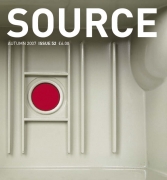The Continuity of Landscape
Simon Denison: Living Landscapes - Wolverhampton Art Gallery 14th July - 25th August 2007
Review by Sara-Jayne Parsons
Issue 52 Autumn 2007
View Contents ▸
The Black Country Consortium is a community project which aims to transform the quality of life for over a million people living in the West Midlands through the creation a new urban park. It is one of six hopeful regeneration projects currently shortlisted for funding to the tune of £50 million through Living Landmarks: People's Million Award, a competitive nationwide initiative organized by the Big Lottery Fund in conjunction with ITV. The winning project will be decided by a televised public vote later this year.
In an astute and strategic move to coincide with the Black Country Consortium bid, photographer Simon Denison was commissioned by the Wolverhampton Art Gallery to produce new work that spoke to the pertinent theme of regeneration and highlighted the context of this local endeavour to create new green spaces. Presented as the first part of an ongoing series City Land (i): Black Country, Denison's six large, colour panoramic views of the West Midlands landscape show the geological and industrial history of the area. There is a straightforwardness in his engagement with these views as he rejects an idealized view of nature and challenges traditional ideas of the picturesque. His gaze is not that of a tourist; he is interested in time and continuity in landscape and doesn't try to mask the legacy of industry in favour of a more traditional scenic experience. The terrain of the Black Country is framed as mostly mundane and unremarkable. Modern day housing estates exist alongside the historic architecture and physical scars of mining, quarrying and manufacturing. Sandstone: Handsworth Golf Course looking North to
M5/M6 interchange, Sandwell Valley, Birmingham
Sandstone: Handsworth Golf Course looking North to
M5/M6 interchange, Sandwell Valley, Birmingham
Yet the tone of Denison's eco-message is optimistic and his photographs acknowledge that nature and the man-made environment already co-exist and continue to evolve; suggesting that 'Black Country' has become a misnomer.
And although these cultural landscapes are spaces marked by time where the present is tangibly pierced by the past, Denison's sense of place is pragmatic rather than poetic. He avoids nostalgia by foregrounding taxonomy as suggested by the titles of the photographs which note geological data and location: Fireclay: Doulton's clay pit with Brierley Hill Tower Blocks, Saltwells Nature Reserve, Dudley and Limestone: Wren's Nest fossil beds with housing estates, Dudley.
Furthermore, local geological specimens on exhibit alongside the photographs give evidence of a landscape that evolved over many millions of years. Viewers are encouraged to envision quite a different Black Country than the more familiar one of recent centuries; a landscape that was once a shallow tropical sea with coral reefs which later evolved into a coastal swamp.
The contemporary green spaces that Denison draws our attention to are the places people play. They are mostly sites of unofficial recreation where wasteland and the limits of industry have been reclaimed as a breathing space by local populations, and nature attempts to win back its territory through weeds and thick undergrowth. Here people walk their dogs, ride bikes and try their luck at fishing in the canals. Leisure is homespun and not prescribed; paths are routes that have been established by popular consensus. Some of the locations provide a view, enabling people to survey their locale - which always appears in Denison's backgrounds, albeit sometimes barely visible, - and beyond, towards the horizon.
One would be hard pressed to characterise Denison's views as scenic or charming. Conceptually his challenge to the notion of the picturesque is ever-present but it is interesting to consider that ironically some of Denison's photographs rely on the understated use of formal historic picturesque tropes. For example, the pictorial success of Coal: Walsall Canal at Moxley, Darlaston relies on interest created through the diversity of varying textures of plants and shrubs set against the smooth watery surface of the canal. The dramatic contrast in light and shade throughout the scene where dark storm clouds contrast with patches of bright sunlight further emphasizes the complexity of the landscape.
Similarly, the potential for the picturesque appears in Sandstone: Handsworth Golf Course looking North to M5/M6 interchange, Sandwell Valley, Birmingham. Unlike most of the other images, the photograph gives a view of a carefully managed landscape. In abstract terms the golf course is presented as a bucolic scene of nature and leisure in coexistence with man-made structures. Yet the aesthetics of golf course design were originally based on eighteenth century notions of the picturesque. Essentially the golf course is fake nature; so the suggestion of a peaceful coexistence of the natural and man-made is somewhat problematic here. Nevertheless, the formal drama of this image is striking. Its power lies in the simple juxtaposition of scale between a series of monumental electricity pylons and two golfers located on an archetypal kidney-shaped green. I also can't help thinking that this photograph is a respectful nod to John Davies' Agecroft Power Station where a local football game foregrounds the site of some massive concrete cooling towers.
Ultimately Denison's photographs reveal a landscape coming to terms with the uneasy relationship between a working past and post-industrial present, an issue that surfaces in many other contemporary British cities that are experiencing regeneration. Interestingly, and whether intended or not, the installation of Denison's photographs in a space that connects the old part of the Wolverhampton Art Gallery building to its new dynamic extension, is a thoughtful spatial metaphor. It is also complimentary to the vision and aspirations of the Black Country Consortium.
Other articles mentioning Simon Denison:
Other articles on photography from the 'Landscape' category ▸






